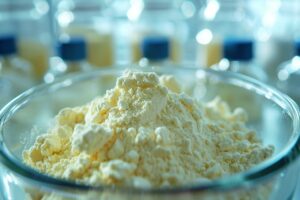Overview
4-Difluoromethoxy-3-hydroxybenzaldehyde is a chemically versatile compound with significant applications across various sectors. As an expert in organic synthesis, it is imperative to understand the breadth of this compound’s utility. This article outlines the top 10 applications of 4-Difluoromethoxy-3-hydroxybenzaldehyde, emphasizing its relevance and impact on different industries.
Applications
Pharmaceutical Synthesis
In the pharmaceutical industry, 4-Difluoromethoxy-3-hydroxybenzaldehyde is a critical intermediate in the synthesis of various therapeutic agents. Its unique structural properties facilitate the development of drugs targeting conditions such as cancer, inflammation, and infectious diseases. The compound’s versatility allows for the efficient construction of complex molecular frameworks essential for effective pharmaceuticals.

Agrochemical Development
The agrochemical sector leverages 4-Difluoromethoxy-3-hydroxybenzaldehyde in the formulation of herbicides, insecticides, and fungicides. Its integration into agrochemical products enhances their efficacy and selectivity, contributing to improved crop protection and agricultural productivity. The compound’s role in agrochemical synthesis underscores its importance in sustainable agricultural practices.
Material Science
In material science, 4-Difluoromethoxy-3-hydroxybenzaldehyde is utilized to develop advanced polymers and resins. Its incorporation modifies the physical and chemical properties of materials, resulting in high-performance coatings, adhesives, and composites. These materials find extensive applications in industries such as automotive, aerospace, and construction, where enhanced durability and performance are critical.
Organic Synthesis
4-Difluoromethoxy-3-hydroxybenzaldehyde serves as a valuable reagent in organic synthesis. It is employed in various chemical reactions, including aldol condensations, Wittig reactions, and Michael additions, facilitating the construction of intricate molecular architectures. Its reactivity and stability make it an indispensable tool for chemists in the synthesis of complex organic molecules.

Fragrance and Flavor Industry
The fragrance and flavor industry benefits from 4-Difluoromethoxy-3-hydroxybenzaldehyde as an aromatic intermediate. Its pleasant odor and compatibility with other compounds make it a preferred choice for creating perfumes, colognes, and flavorings. The compound’s role in this industry highlights its contribution to consumer products and quality of life.
Biomedical Research
In biomedical research, 4-Difluoromethoxy-3-hydroxybenzaldehyde is employed to study various biological processes and pathways. It is used in labeling and tracing experiments, aiding scientists in investigating cellular mechanisms, protein interactions, and metabolic pathways. The compound’s application in biomedical research advances our understanding of human health and disease.
Chemical Sensors
4-Difluoromethoxy-3-hydroxybenzaldehyde is integral to the development of chemical sensors. Its chemical properties enable the creation of sensitive and selective sensors capable of detecting trace amounts of environmental pollutants, hazardous substances, and biochemical markers. These sensors play a crucial role in environmental monitoring and public safety.
Photovoltaic Cells
In renewable energy research, 4-Difluoromethoxy-3-hydroxybenzaldehyde is explored for its potential in photovoltaic cell technology. Researchers investigate its role in enhancing the efficiency and stability of organic solar cells, contributing to the development of sustainable energy solutions. The compound’s application in this field underscores its significance in addressing global energy challenges.
Environmental Chemistry
Environmental chemists utilize 4-Difluoromethoxy-3-hydroxybenzaldehyde in the analysis and remediation of pollutants. Its application in environmental monitoring and cleanup processes aids in the detection and removal of contaminants from soil, water, and air, promoting a cleaner and healthier environment. The compound’s role in environmental chemistry highlights its importance in sustainable environmental practices.

Academic Research
Academic institutions and research laboratories use 4-Difluoromethoxy-3-hydroxybenzaldehyde as a model compound in various educational and research projects. Its versatility and broad range of applications make it an ideal subject for teaching fundamental concepts in chemistry and conducting innovative research. The compound’s inclusion in academic research fosters the next generation of scientists and advances scientific knowledge.
Conclusion
4-Difluoromethoxy-3-hydroxybenzaldehyde is a compound of significant importance across multiple fields, from pharmaceuticals and agrochemicals to material science and renewable energy. Its diverse applications demonstrate its critical role in advancing scientific research and industrial development. As the demand for novel chemical compounds continues to grow, the relevance of 4-Difluoromethoxy-3-hydroxybenzaldehyde in driving innovation and progress remains paramount.







